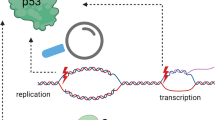Abstract
Nucleophosmin (NPM) is a ubiquitously expressed nucleolar phosphoprotein that continuously shuttles between the nucleus and cytoplasm1. It has been proposed to function in ribosomal protein assembly and transport2, and also as a molecular chaperone that prevents proteins from aggregating in the crowded environment of the nucleolus3. The NPM gene is involved in several tumour-associated chromosome translocations, which have resulted in the formation of fusion proteins that retain the amino terminus of NPM, including NPM–ALK4, NPM–RAR5 and NPM–MLF1 (ref. 6). It is generally thought that the NPM component is not involved in the transforming potential of these fusion proteins7, but instead provides a dimerization interface for the oligomerization and the oncogenic conversion of the various NPM partners (ALK, RAR, MLF1). Here we show that NPM interacts directly with the tumour suppressor p53, regulates the increase in stability and transcriptional activation of p53 after different types of stress, and induces p53-dependent premature senescence on overexpression in diploid fibroblasts. These findings indicate that NPM is a crucial regulator of p53 and suggest that alterations of the NPM function by NPM fusion proteins might lead to deregulation of p53 in tumours.
This is a preview of subscription content, access via your institution
Access options
Subscribe to this journal
Receive 12 print issues and online access
$209.00 per year
only $17.42 per issue
Buy this article
- Purchase on Springer Link
- Instant access to full article PDF
Prices may be subject to local taxes which are calculated during checkout




Similar content being viewed by others
References
Borer, R. A., Lehner, C. F., Eppenberger, H. M. & Nigg, E. A. Cell 56, 379–390 (1989).
Olson, M. O., Wallace, M. O., Herrera, A. H., Marshall-Carlson, L. & Hunt, R. C. Biochemistry 25, 484–491 (1986).
Szebeni, A. & Olson, M. O. Protein Sci. 8, 905–912 (1999).
Morris, S. W. et al. Science 263, 1281–1284 (1994).
Redner, R. L., Rush, E. A., Faas, S., Rudert, W. A. & Corey, S. J. Blood 87, 882–886 (1996).
Yoneda-Kato, N. et al. Oncogene 12, 265–275 (1996).
Bischof, D., Pulford, K., Mason, D. Y. & Morris, S. W. Mol. Cell. Biol. 17, 2312–2325 (1997).
Dimri, G. P. et al. Proc. Natl Acad. Sci. USA 92, 9363–9367 (1995).
Harvey, M. et al. Oncogene 8, 2457–2467 (1993).
Valdez, B. C. et al. J. Biol. Chem. 269, 23776–23783 (1994).
Li, Y. P. J. Virol. 71, 4098–4102 (1997).
Llanos, S., Clark, P. A., Rowe, J. & Peters, G. Nature Cell Biol. 3, 445–452 (2001).
Serrano, M., Lin, A. W., McCurrach, M. E., Beach, D. & Lowe, S. W. Cell 88, 593–602 (1997).
Lin, A. W. & Lowe, S. W. Proc. Natl Acad. Sci. USA 98, 5025–5030 (2001).
Wu, X., Bayle, J. H., Olson, D. & Levine, A. J. Genes Dev. 7, 1126–1132 (1993).
el-Deiry, W. S. et al. Cell 75, 817–825 (1993).
Elbashir, S. M. et al. Nature 411, 494–498 (2001).
Allan, L. A. & Fried, M. Oncogene 18, 5403–5412 (1999).
Kastan, M. B. et al. Cell 71, 587–597 (1992).
Mattern, K. A., Humbel, B. M., Muijsers, A. O., de Jong, L. & van Driel, R. J. Cell. Biochem. 62, 275–289. (1996).
Jiang, M. et al. Oncogene 20, 5449–5458 (2001).
He, L. Z., Merghoub, T. & Pandolfi, P. P. Oncogene 18, 5278–5292 (1999).
Grignani, F. et al. Cell 74, 423–431 (1993).
Pearson, M. et al. Nature 406, 207–210 (2000).
Fogal, V. et al. EMBO J. 19, 6185–6195 (2000).
Deveraux, Q., Ustrell, V., Pickart, C. & Rechsteiner, M. J. Biol. Chem. 269, 7059–7061 (1994).
Cordell, J. L. et al. Blood 93, 632–642 (1999).
Thullberg, M. et al. Hybridoma 19, 63–72 (2000).
Acknowledgements
We thank K. Helin, M. Pearson and A. Ventura for discussions; S. Polo for the GST–S5a construct; and E. Canidio for technical support. J.-C.M. and E.C. are recipients of fellowships from the European Community (Marie Curie Fellowship) and the Association for International Cancer Research (AICR), respectively. This work was supported by grants from the AIRC and the European Community.
Author information
Authors and Affiliations
Rights and permissions
About this article
Cite this article
Colombo, E., Marine, JC., Danovi, D. et al. Nucleophosmin regulates the stability and transcriptional activity of p53. Nat Cell Biol 4, 529–533 (2002). https://doi.org/10.1038/ncb814
Received:
Revised:
Accepted:
Published:
Issue Date:
DOI: https://doi.org/10.1038/ncb814
This article is cited by
-
A role for the NPM1/PTPN14/YAP axis in mediating hypoxia-induced chemoresistance to sorafenib in hepatocellular carcinoma
Cancer Cell International (2022)
-
Mechanisms of nucleophosmin (NPM)-mediated regulated cell death elucidated by Hsp70 during renal ischemia
Apoptosis (2022)
-
Doxorubicin induces an alarmin-like TLR4-dependent autocrine/paracrine action of Nucleophosmin in human cardiac mesenchymal progenitor cells
BMC Biology (2021)
-
Ribosomal L1 domain-containing protein 1 coordinates with HDM2 to negatively regulate p53 in human colorectal Cancer cells
Journal of Experimental & Clinical Cancer Research (2021)
-
HO-1 nuclear accumulation and interaction with NPM1 protect against stress-induced endothelial senescence independent of its enzymatic activity
Cell Death & Disease (2021)



